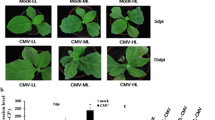Abstract
In tobacco (Nicotiana tabacum L. cv. Xanthinc), salicylic acid (SA) levels increase in leaves inoculated by necrotizing pathogens and in healthy leaves located above the inoculated site. Systemic SA increase may trigger disease resistance and synthesis of pathogenesis-related proteins (PR proteins). Here we report that ultraviolet (UV)-C light or ozone induced biochemical responses similar to those induced by necrotizing pathogens. Exposure of leaves to UV-C light or ozone resulted in a transient ninefold increase in SA compared to controls. In addition, in UV-light-irradiated plants, SA increased nearly fourfold to 0.77 μg·g−1 fresh weight in leaves that were shielded from UV light. Increased SA levels were accompanied by accumulation of an SA conjugate and by an increase in the activity of benzoic acid 2-hydroxylase which catalyzes SA biosynthesis. In irradiated and in unirradiated leaves of plants treated with UV light, as well as in plants fumigated with ozone, PR proteins 1a and 1b accumulated. This was paralleled by the appearance of induced resistance to a subsequent challenge with tobacco mosaic virus. The results suggest that UV light, ozone fumigation and tobacco mosaic virus can activate a common signal-transduction pathway that leads to SA and PR-protein accumulation and increased disease resistance.
Similar content being viewed by others
Abbreviations
- PR protein:
-
pathogenesis-related protein
- SA:
-
salicylic acid
- TMV:
-
tobacco mosaic virus
- UV:
-
ultraviolet
References
Apostol, I., Heinstein, P.F., Low, P.S. (1989) Rapid stimulation of an oxidative burst during elicitation of cultured plant cells. Plant Physiol. 90, 109–116
Bors, W., Heller, W., Michel, C., Saran, M. (1989) Flavonoids as antioxidants. Methods Enzymol. 186, 343–355
Brederode, F.T., Linthorst, H.J.M., Bol, J.F. (1991) Differential induction of acquired resistance and PR gene expression by virus infection, ethephon treatment, UV light and wounding. Plant Molec. Biol. 17, 1117–1125
Chappell, J., Hahlbrock, K. (1984) Transcription of plant defense genes in response to UV light or fungal elicitor. Nature 311, 76–78
Chester, K.S. (1933) The problem of acquired physiological immunity in plants. Quart. Rev. Biol. 8, 275–324
Dixon, R.A., Lamb, C.J. (1990) Molecular communication in interactions between plants and microbial pathogens. Annu. Rev. Plant Physiol. Plant Mol. Biol. 41, 339–367
Enyedi, A.J., Raskin, I. (1993) Induction of UDP-glucose:salicylic acid glucosyltransferase activity in tobacco mosaic virus-inoculated tobacco (Nicotiana tabacum) leaves. Plant Physiol. 101, 1375–1380
Enyedi, A.J., Yalpani, N., Silverman, P., Raskin, I. (1992) Localization, conjugation, and function of salicylic acid in tobacco during the hypersensitive reaction to tobacco mosaic virus. Proc. Natl. Acad. Sci. USA 89, 2480–2484
Ernst, D., Schraudner, M., Langebartels, C., Sandermann, H. (1992) Ozone-induced changes of mRNA levels of β-1,3-glucanase, chitinase and ‘pathogenesis-related’ protein 1b in tobacco plants. Plant Mol. Biol. 20, 673–682
Gilpatrick, J.D., Weintraub, M. (1952) An unusual type of protection with the carnation mosaic virus. Science 115, 701–702
Heath, R.L. (1988) Biochemical mechanisms of pollutant stress. In: Assessment of crop loss from air pollutants, pp. 259–286, W.W. Heck, O.C. Taylor, D.T. Tingey, eds., Elsevier, London
Imbrie, C.W., Murphy, T.M. (1984) Mechanism of photoinactivation of plant plasma membrane ATPase. Photochem. Photobiol. 40, 243–248
Kuhn, D.L., Chappell, J., Boudet, A., Hahlbrock, K. (1984) Induction of phenylalanine ammonia-lyase and 4-coumarate:CoA ligase mRNAs in cultured plant cells by UV light and fungal elicitor. Proc. Natl. Acad. Sci. U.S.A. 81, 1102–1106
León, J., Yalpani, N., Raskin, I., Lawton, M. (1993) Induction of benzoic acid 2-hydroxylase in virus-inoculated tobacco. Plant Physiol. 103, 323–328
Malamy, J., Carr, J.P., Klessig, D.F., Raskin, I. (1990) Salicylic acid — a likely endogenous signal in the resistance response of tobacco to tobacco mosaic virus infection. Science 250, 1002–1004
Métraux, J.P., Signer, H., Ryals, J., Ward, E., Wyss-Benz, M., Gaudin, J., Raschdorf, K., Schmid, E., Blum, W., Inverardi, B. (1990) Increase in salicylic acid at the onset of systemic acquired resistance in cucumber. Science 250, 1004–1006
Rasmussen, J.B., Hammerschmidt, R., Zook, M.N. (1991) Systemic induction of salicylic acid accumulation in cucumber after inoculation with Pseudomonas syringae pv. syringae. Plant Physiol. 97, 1342–1347
Rosemann, D., Heller, W., Sandermann, H. (1991) Biochemical plant responses to ozone. II. Induction of stilbene biosynthesis in Scots pine (Pinus sylvestris L.) seedlings. Plant Physiol. 97, 1280–1286
Ross, A.F. (1961a) Systemic acquired resistance induced by localized virus infections in plants. Virology 13, 340–358
Ross, A.F. (1961b) Localized acquired resistance to plant virus infection in hypersensitive hosts. Virology 14, 329–339
Schraudner, M., Ernst, D., Langebartels, C., Sandermann, H. (1992) Biochemical plant responses to ozone. III. Activation of the defense-related proteins β-1,3-glucanase and chitinase in tobacco leaves. Plant Physiol. 99, 1321–1328
Silverman, P., Nuckles, E., Ye, X.S., Kuc, J., Raskin, I. (1993) Salicylic acid, ethylene, and pathogen resistance in tobacco. MPMI 6, 775–781
Ward, E.R., Uknes, S.J., Williams, S.C., Dincher, S.S., Wiederhold, D.L., Alexander, D.C., Ahl-Goy, P., Métraux, J.P., Ryals, J.A. (1991) Coordinate gene activity in response to agents that induce systemic acquired resistance. Plant Cell 3, 1085–1094
Yalpani, N., Raskin, I. (1993) Salicylic acid: a systemic signal in plant disease resistance. Trends Microbiol. 1, 88–92
Yalpani, N., Silverman, P., Wilson, T.M.A., Kleier, S.A., Raskin, I. (1991) Salicylic acid is a systemic signal and an inducer of pathogenesis-related proteins in virus-infected tobacco. Plant Cell 3, 809–818
Yalpani, N., Leon, J., Lawton, M.A., Raskin, I. (1993) Pathway of salicylic acid biosynthesis in healthy and virus-inoculated tobacco. Plant Physiol. 103, 315–321
Author information
Authors and Affiliations
Corresponding author
Additional information
This work was financed by grants from the U.S. Department of Agriculture (Competitive Research Grants Office), Division of Energy Biosciences of U.S. Department of Energy, the Rockefeller Foundation, the New Jersey Commission for Science and Technology, and the New Jersey Agricultural Experiment Station.
Rights and permissions
About this article
Cite this article
Yalpani, N., Enyedi, A.J., León, J. et al. Ultraviolet light and ozone stimulate accumulation of salicylic acid, pathogenesis-related proteins and virus resistance in tobacco. Planta 193, 372–376 (1994). https://doi.org/10.1007/BF00201815
Received:
Accepted:
Issue Date:
DOI: https://doi.org/10.1007/BF00201815




